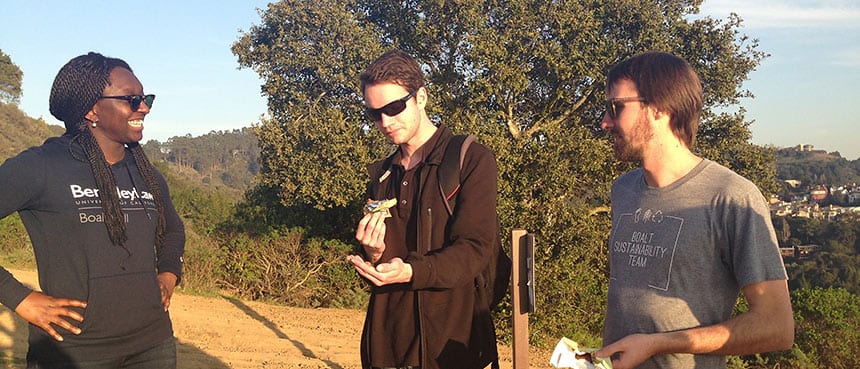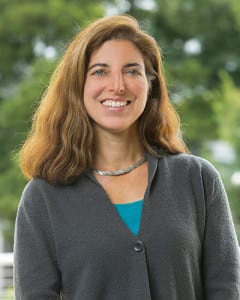
By Andrew Cohen
Whether discussing climate change, policy reform, or her expectations for Berkeley Law’s new Environmental Law Clinic, Claudia Polsky ’96 is propelled by a sense of planetary urgency.
“I’m not inclined to add another amicus brief to 15 others in a case simply because it would give students useful experience writing an amicus brief,” said Polsky, the clinic’s director. “In a world of rapidly rising temperatures and pollution levels, and an alarming rate of species extinction, we need to make a real-world difference in addition to teaching lawyering skills.”
While focusing intensively on certain issue areas, her project criteria includes making a significant impact, identifying leverage points that spark meaningful reform, and choosing initiatives with a real chance to succeed.
Using that rubric, clinic students are tackling three client projects this semester. One analyzes whether the Environmental Protection Agency (EPA) should consider the monetary costs of cleaning downstream pesticide-polluted water when deciding whether to authorize pesticides for nationwide use—which could affect numerous regulatory decisions. Another project seeks to compel a state agency to disclose its health assessment and precautionary recommendations regarding cell phones’ electro-magnetic fields. A third involves shaping California auto insurance policies to incentivize people to cut down on nonessential driving, which research indicates could reduce auto-related greenhouse gas emissions by up to eight percent.
“I’ve already learned so much, including that environmental initiatives and change can come from anywhere—even the most unlikely areas,” says LL.M. student Nnanke Williams ’16, who works on the auto insurance project team. “Our research area is vast and challenging, but it’s also very inspiring to work with such great teammates.”
Buoyed by the clinic “showing us how research should be conducted,” Williams plans to pursue a career in environmental law after graduating. “I’ve seen my position on the solutions to these issues evolving the deeper I go into the research,” she says. “That shows just how multifaceted these policy issues are.”
World of experience
Before signing on to lead the clinic, Polsky spent most of the past 15 years as a deputy attorney general at the California Department of Justice—where she became a go-to litigator on high-level environmental cases, and helped state agencies draft environmental regulations. She also worked for the California Department of Toxic Substances Control, the Earthjustice Legal Defense Fund, and Public Citizen Litigation Group. In her previous positions, she spent seven years supervising law clerks.

While initially concerned about “how students would handle the complexity” of the clinic’s projects, Polsky has been pleasantly relieved. “I picked hard ones because they’re important, and I was worried about maybe having to tamp down the expectations,” she said. “But the capacity of these students to handle high-level, high-volume work is really impressive. They’ve met the challenge consistently, and the collaboration within teams has been terrific.”
Clinic students gain valuable experience in administrative agency practice, litigation, legislation, and policymaking. Clients include nonprofits, state agencies, environmental justice coalitions, and academic researchers working to identify emerging environmental threats.
Polsky said the clinic will focus on five areas: climate change, toxics reduction, the human right to water for drinking and sanitation, green job creation, and equity in access to nature. By prioritizing those areas, she foresees the development of clinic issue expertise, enduring client relationships, and the ability to do ever more sophisticated work to create systems change.
How best to achieve that? “Figure out a problem space where no one else is working, and find out how far up in the causation chain we can intervene,” Polsky said. “Our projects are all geared towards identifying a leverage point where moving one piece will trigger a cascade of downstream environmental and social goods.”
New student environment
Clinic student Eric Moorman ’16 “greatly appreciates” the chance to gain insights into critical environmental law and policy issues “while developing advocacy skills through hands-on public interest work. The opportunity to assist an actual client on a real-world problem is invaluable.”
His current work examines how the EPA decides to approve pesticides for nationwide use, and which factors it considers in making those decisions. By critiquing the EPA’s overly selective examination of the costs and benefits of particular pesticides, the clinic hopes to help its client re-orient the agency’s approach towards prevention of pesticide water pollution.
“I’ve learned how tough it is to recover decades-old public documents from federal administrative agencies, and to determine exactly what factors go into their decision-making processes,” Moorman said. Undaunted, he added that his clinic experience “provides a better sense of what many environmental lawyers do and the challenges they face on a day-to-day basis”—fueling his desire to make an impact in the field after graduating.
In tandem with working on projects and receiving structured team and individual feedback, clinic students attend a two-hour weekly seminar. It provides a historical context for their work, substantive law and advocacy modes relevant to clinic projects, training in project and time management, and opportunities to develop oral advocacy skills. Polsky also takes her students out to learn about their physical environment—including a recent class held during a hike through Claremont Canyon, which combined local ecology, a discussion of multi-jurisdictional management conflict over fire risk-reduction methods, a lesson on writing, and a pink-orange sunset.
Thanks to a recent generous donor gift, the clinic will bring on a two-year fellow this fall to focus on environmental justice issues. That will increase the clinic’s capacity from seven to 10 or more students, expand its client reach, and fortify collaborations with other units in the law school and across campus.
“It was hard to launch this clinic from a standing start,” Polsky said. “Coming from a state agency, I couldn’t bring over any clients. But we’re getting more and more interesting and challenging projects crossing our desk every day, and I’m truly amazed by our students’ capacity to tackle every challenge I put before them. It is a great privilege to be here.”